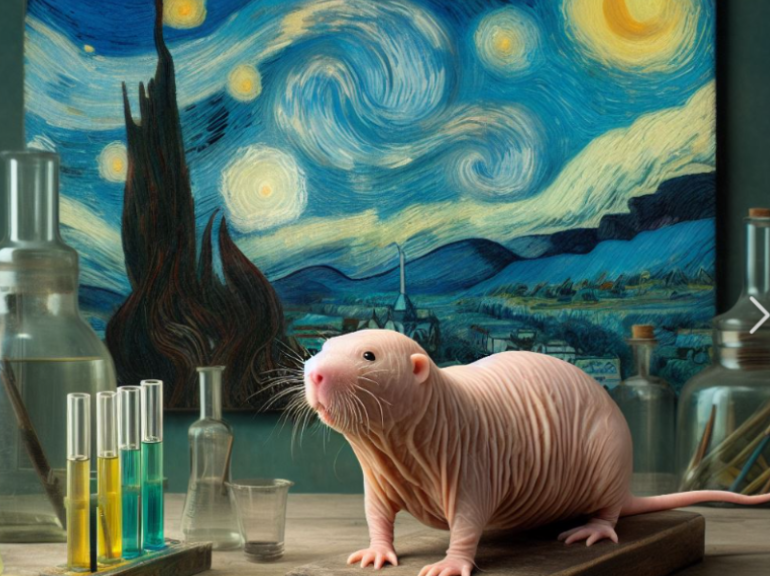Back in the 1900s, the pioneer immunologist Elie Metchnikoff, vice president of the Pasteur Institute in Paris, wrote, “Aging is a disease and it should be treated like any other.” His work helped to shape interest in aging as a manageable problem. (Source)
This month’s theme: Naked Mole Rats
Introduction
Naked mole rats, often known as the « sand puppy” and scientifically known as Heterocephalus glaber (NMRs), hold the distinction of being the lengthiest-lived rodents in the animal kingdom, boasting an impressive maximum lifespan of 30 years. This longevity surpasses expectations based on their diminutive body size by a remarkable factor of five. These remarkably social, mouse-sized rodents are indigenous to the arid and semiarid regions of the Horn of Africa and parts of Kenya, particularly in Somali regions, where they naturally inhabit subterranean burrows. Due to their exceptional characteristics, they have become invaluable subjects for scientific investigations encompassing behavioral studies, neurological research, ecophysiological inquiries and especially geroscience!
Those strange looking (ugly) animals are also specific in other ways. As an adaptation to life in burrows, a stable underground environment that can be lacking respirable air, they are able to survive with less oxygen than other mammals. but they have difficulties changing their internal temperature. Naked mole rats together with the close Damaraland mole-rat are considered the only mammals being « eusocial », living in groups with only a « queen mother ».
Do they age ?
You can define aging in many ways. One of the ways of defining it is a degradation phenomenon, having for consequence that the probability to die augments with age.
For humans, this is called the Gompertz law, more precisely, the Gompertz–Makeham law of mortality. From age 30, the probability to die doubles each 8 years. For many animals, there is a similar curve, but the rate of doubling is very different. For example, for mice, the probability to die doubles each 3 months.
We have reliable statistics for mortality of humans, rats, mice and some other mammals living with humans. But statistics are far less easy to establish for wild animals.
Concerning naked mole rats, a few colonies have been kept in captivity since decennia. The positive news is that there is no measurable growth of the rate of mortality. This was measured 5 years ago and again recently. Does this mean that those mammals are « biologically immortal »? We are far from sure at the moment.
First, the number of naked-mole rats proven to be still alive at an advanced age is until now low. The oldest animals are barely 30 years old and only one animal reached the age of 40. So, those statistics have to be confirmed.
It is true that a lifespan of forty years is almost 10 times longer than the maximal lifespan of rats and mice. However, this lifespan is not so much longer than the oldest long living rodents that are squirrels (23 years and 6 months). And there are even other small mammals who have a longer lifespan. A Brandt’s bat (Myotis brandtii) has been living in the wild for at least 41 years.
Also, it could be that the rate of mortality stops increasing until a certain age, but that the process of accumulation doesn’t stop, still inevitably leading to the death of old age after a « plateau ».The fact that the epigenetic age of naked-mole rats changes with age and the fact that very old individuals look older than younger ones are elements tending to confirm this hypothesis. Unfortunately for researchers hoping to find a recipe for longevity.
Transferring the genes of longevity
It is not sure that genetic differences between humans have a very big influence. What we found until know is only that many ((combination of)) genes have a moderate impact.
But it is certain that genetically close animals have very different maximal lifespans. So, the transfer of longevity genes is a possible solution.
This was recently tested on naked-mole rats to mice. The gene transferred improves the production of Hyaluronic acid, a substance with many positive aspects. The result of the first experiment is relatively good. Indeed « Increased hyaluronan by naked mole-rat Has2 improves healthspan in mice,” The lifespan extension is between 4,4 and 16 % (for male mices) according to different estimates.
Conclusion:
Will we have in a not so far future changes as spectacular as the changes in lifespan obtained many years ago with genetic changes in C Elegans worms with doubling of lifespan? We do not know, and the longevity field is complicated. But we should certainly try, with help from naked-mole-rats and also with help of A.I. to better understand, examine, compare, curate data and have clinical trials on rats and on humans.
The good news of the month: Dublin Longevity Declaration.
You are invited to sign this declaration. An increase in healthy lifespans, through much better treatment of age-related diseases would deliver extraordinary benefits, including savings of literally trillions of dollars per year in healthcare costs.
Dozens of world-leading experts, hundreds of scientists and thousands of « ordinary » citizens declare that such an advance is now potentially within reach, by targeting the underlying processes of aging, and that efforts to achieve it should be immediately and greatly expanded.
For more information
- Heales, Longevity Escape Velocity Foundation, International Longevity Alliance, Longecity and Lifespan.io
- Heales Monthly Science News
- Heales YouTube channel
- Source of the image: prompt Dessine un rat-taupe nu dans un laboratoire avec des éprouvettes style Van Gogh
- Contact us

